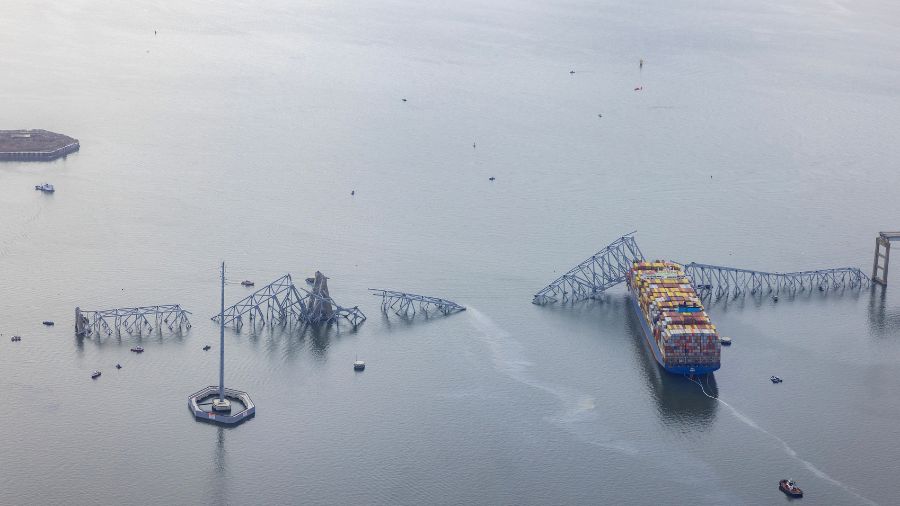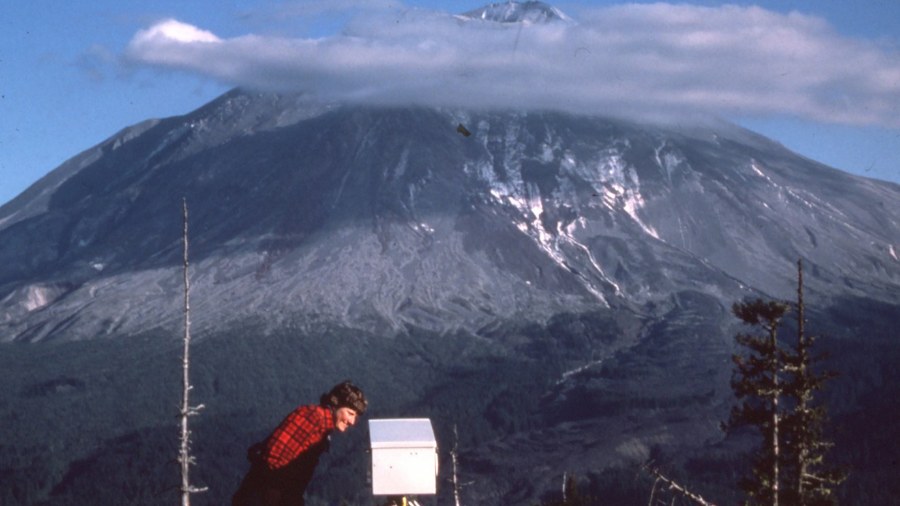Baltimore bridge collapse reminds Washingtonians of past disasters
Mar 26, 2024, 3:11 PM

In an aerial view, the cargo ship Dali sits in the water after running into and collapsing the Francis Scott Key Bridge on March 26, 2024 in Baltimore, Maryland. (Photo: Tasos Katopodis, Getty Images)
(Photo: Tasos Katopodis, Getty Images)
A large container ship lost power and rammed into the Francis Scott Key Bridge in Baltimore early Tuesday, causing the bridge to collapse into the Patapsco River below.
Six construction workers are presumed dead chunks of the 47-year-old bridge plunged into the river. First responders and rescue teams remain active in the search for the missing people.
More from Maryland: Baltimore bridge collapses after powerless cargo ship rams into support column
Kevin Cartwright, director of communications for the Baltimore Fire Department, told The Associated Press the collapse is a “developing mass casualty event.”
“Like everyone else, I was shocked to see how quickly the bridge went down, and I was worried for those who were missing,” Chris Sullivan, traffic reporter for KIRO Newsradio, said. “But then I started thinking about our bridges and where something like this could happen in Washington. I immediately thought of the Astoria-Megler Bridge over the Columbia River. Huge ships go through there.
“Cargo ships also pass under the Lewis and Clark Bridge in Longview,” Sullivan continued. “Both of those bridges have supports that could be vulnerable to a drifting, powerless ship like this. We forget, but Washington is still very much a maritime state.”
The bridge disaster near Baltimore is a reminder that the Pacific Northwest has experienced more than its fair share of issues with spans carrying motor vehicle traffic over bodies of water.
1940: Tacoma Narrows Bridge collapse
The original bridge opened to traffic on July 1, 1940 and immediately faced problems. The bridge was so flexible and so sensitive to wind, that it would bounce up and down and twist and roll from side to side to a dramatic and alarming degree, unofficially dubbed as “Galloping Gertie.”
Just four months later, on Nov. 7, 1940, the bridge collapsed during a windstorm with debris tumbling into the Tacoma Narrows strait. No human lives were lost, though a three-legged cocker spaniel named Tubby died in the accident.
“The bridge at that time I arrived was swinging very wildly from side to side and also up and down,” Owens said. “There was one car on the bridge and a truck loaded with lumber. And the car was bouncing. In fact, it left the deck of the bridge and turned over on its side. Then at 11:10 a.m., there was one big heave to the north, it swung back to the south, and she began to break up.”
More on the Tacoma Narrows Bridge collapse: Vintage audio from 1940 collapse
1978: West Seattle Bridge struck by freighter
Early on the Sunday morning of June 11, 1978, a southbound 550-foot long freighter called the M/V Chavez was headed up the Duwamish to the Kaiser Cement Plant with a load of gypsum. Both the north and south bridges were opened to allow the Chavez to pass.
On the southbound ship, an 80-year-old Puget Sound pilot named Rolf Neslund was at the helm when something went wrong, and the vessel hit the east side of the north bridge. And the Chavez hit it hard. So hard, in fact, wood, metal and concrete sections of the eastern half of the drawbridge were splintered, bent and shattered. Worst of all, the east half of the drawbridge was now stuck in the up position. It would remain that way for a couple of years.
With the north bridge knocked out of service, vehicle traffic was temporarily rerouted. Both directions now had to cross the south bridge with a whole set of changing detours that stretched into years of inconvenience.
More on Seattle Bridge damage: Twisted tales of the West Seattle Bridge
1979: Hood Canal Floating Bridge sinks in windstorm
On either side of the draw span, the Hood Canal Floating Bridge consisted of a series of floating concrete pontoons connected to each other, and to a “highrise” at the west and east ends of the bridge. The pontoons were also connected via steel cables to concrete anchors set into the bottom of Hood Canal.
On the night of Feb. 12, 1979, the region was struck by a Puget Sound wind event. Around 6 a.m. the next day, the wind was gusting from the south at more than 100 mph. The floating pontoons on the west half of the bridge began taking on water and listing around 6:40 a.m. Around 7:15 a.m., the western section, including Pontoons A through M – each 360 feet long, broke loose, drifted slightly north and then rolled over and sank to the bottom of Hood Canal. The western highrise hinged down into the water, but stayed attached to the concrete approach to the west end of the bridge.
“I knew this was worse than any other storm we’d had. It was the combination of factors,” Washington Department of Transportation (WSDOT) Chuck Myers told The Seattle Times. “We’d had winds worse than this, and currents worse. But we’d never had both at the same time.”
Luckily, newspaper accounts at the time reported that four or five passenger cars and a semi-truck had barely made it off the west section of the pontoons before the pontoons broke loose and sank.
More on the windstorm in 1979: What sank the Hood Canal Bridge
1990: Lacey V. Murrow bridge sinks in Lake Washington
Out on Lake Washington, high winds, rain and waves were striking the old pontoons of the 50-year-old Lacey V. Murrow floating bridge. Paul Brendle, KIRO Newsradio’s traffic helicopter pilot, arrived just in time to deliver a gripping live play-by-play of the bridge’s collapse.
“Approximately a third of the old Mercer Island floating bridge that they have been rehabilitating has broken away from the west end and has drifted out at an angle, approximately 20 degrees,” Brendle told KIRO anchors Linda Thomas and Rick Van Cise and thousands of listeners that Sunday morning. “And here it goes now. There’s a huge yellow crane, one of those big construction cranes. And when I made the last pass over a few moments ago, Rick, it was in fact high and dry. And now it’s up to the top of its wheels.
“So this crane will be pitching over any moment and going underwater. It will also go to the bottom of Lake Washington,” Brendle continued. “And another section of the bridge is now giving away, breaking as I’m watching it. Right now the concrete is bubbling. Now it lifts up. The entire section is canted about a 40-degree angle, just like a big battleship rolling over and getting ready to pitch straight down. The crane is gone now.”
The handful of workers on the bridge that morning evacuated safely and nobody was injured when the old bridge sank.
More on the Lacey V. Murrow bridge: Bizarre Lake Washington disaster struck Thanksgiving Weekend 1990
2013: Skagit River Bridge tumbles in the Skagit River
On May 23, 2013, the Skagit River Bridge collapsed when a truck carrying an oversized load struck the overhead support beams, causing it to crumble into the water, along with three people in two cars.
A Washington State Patrol (WSP) report said the oversized load was two inches too high.
“It was just a horrendous boom and things were — it was violent in the cab,” William Scott, the driver of the oversized truck, told the NTSB, according to a transcript included in 2,000 pages of investigative documents reviewed by KIRO 7.
No one was killed in the collapse, but the accident cost the state $17 million to replace the span.
More on the bridge accident: Remembering the Skagit River Bridge collapse, 10 years later
Contributing: Frank Sumrall, MyNorthwest
You can hear Feliks Banel every Wednesday and Friday morning on Seattle’s Morning News with Dave Ross and Colleen O’Brien. Read more from Feliks here and subscribe to The Resident Historian Podcast here. If you have a story idea or a question about Northwest history, please email Feliks.
Follow @https://twitter.com/feliksbanel













